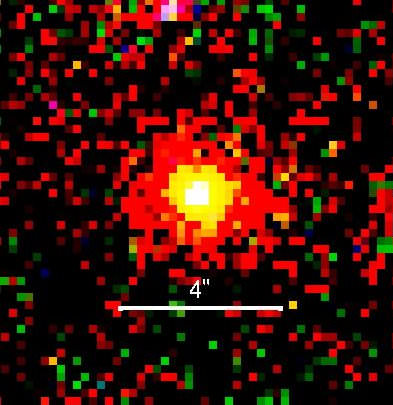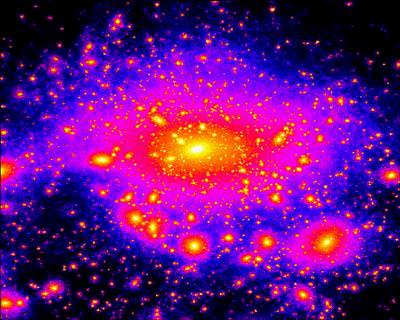Weekend SkyWatcher's Forecast: September 4-6, 2009
 Greetings, fellow SkyWatchers! Ah, yes… Full Moon. Are you ready to howl? If you didn't get a chance to watch the galiean moons do their dance last weekend, then be sure to catch the awesome video you'll find inside! In the meantime, keep your ears alert for the rise of tonight's "Full Corn Moon" and check out the Omicron gems. As the skies get darker, the Herschel challenges warm up – so dust off your optics and I'll see you in the backyard… (...)
Greetings, fellow SkyWatchers! Ah, yes… Full Moon. Are you ready to howl? If you didn't get a chance to watch the galiean moons do their dance last weekend, then be sure to catch the awesome video you'll find inside! In the meantime, keep your ears alert for the rise of tonight's "Full Corn Moon" and check out the Omicron gems. As the skies get darker, the Herschel challenges warm up – so dust off your optics and I'll see you in the backyard… (...)
Read the rest of Weekend SkyWatcher's Forecast: September 4-6, 2009 (1,052 words)
Andromeda Galaxy Eating the Neighborhood
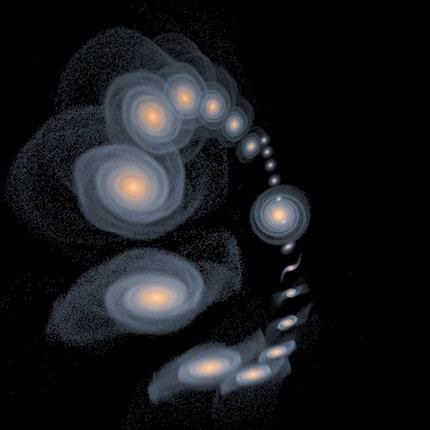
From Earth, the Andromeda Galaxy looks like a calm, bright galaxy, and is visible with the naked eye in our night sky. But astronomers have discovered things aren't as tranquil as it seems over at M31. Andromeda is eating the neighbors.
(...)
Read the rest of Andromeda Galaxy Eating the Neighborhood (366 words)
White Dwarf "Close" to Exploding as Supernova
ESA’s XMM-Newton orbiting X-ray telescope has uncovered the first close-up of a white dwarf star that could explode into a type Ia supernova within a few million years. That's relatively soon in cosmic time frames, and although this white dwarf that is orbiting its companion star HD 49798, is far enough away to pose no danger to Earth, it is close enough to become an extraordinarily spectacular celestial sight. Calculations suggest that it will blaze initially with the intensity of the full Moon and be so bright that it will be seen in the daytime sky with the naked eye. But don't worry, it will be awhile!
(...)
Read the rest of White Dwarf "Close" to Exploding as Supernova (396 words)
NASA Science News for September 3, 2009
The sun is in the pits of the deepest solar minimum in nearly a century. Weeks and sometimes whole months go by without even a single tiny sunspot. Are sunspots disappearing? Experts discuss the question in today's story from Science@NASA.
FULL STORY at
http://science.nasa.gov/headlines/y2009/03sep_sunspots.htm?list1035898
Astronomers Find Most Distant Supermassive Black Hole Yet
A long time ago in a galaxy far, far away there was a supermassive black hole….. Astronomers from the University of Hawaii have spotted a giant galaxy surrounding the most distant supermassive black hole ever found. The galaxy, so distant that it is seen as it was 12.8 billion years ago, is as large as the Milky Way galaxy and harbors a supermassive black hole that contains at least a billion times as much matter as our Sun.
(...)
Read the rest of Astronomers Find Most Distant Supermassive Black Hole Yet (409 words)
Watch Saturn's Rings Disappear (Video)

On September 4, 2009, Earth's orbital motion will carry it through the same plane as Saturn's rings. From our vantage point, the rings will disappear. Usually these ring plane crossings — which only happen about every 15 years — are great opportunities to observe Saturn's moons. But this year's ring plane crossing will be practically impossible to see, as Saturn will be very close to the sun, only 11 degrees away. So, disappointingly, we won't see much. However, amateur astronomer Alan Friedman has given us a glimpse of what this event will look like, without the glare from the sun. Friedman has put together an animation of how the angle of Saturn's rings have changed over the past six years. See the animation below. "It shows the changing plane of the ring system as viewed from my Buffalo backyard from 2004 to 2009," said Friedman. "The final frame has been assembled from earlier 2009 observations to display how the planet will appear with its rings edge on." Gorgeous!
(...)
Read the rest of Watch Saturn's Rings Disappear (Video) (105 words)
New Way to Measure Curvature of Space Could Unite Gravity Theory
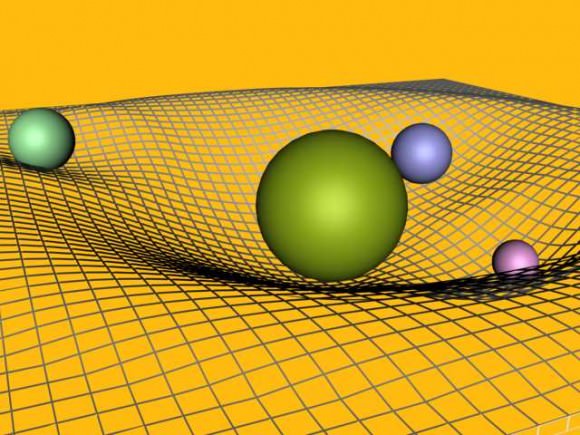
Einstein's general theory of relativity describes gravity in terms of the geometry of both space and time. Far from a source of gravity, such as a star like our sun, space is "flat" and clocks tick at their normal rate. Closer to a source of gravity, however, clocks slow down and space is curved. But measuring this curvature of space is difficult. But now scientists have used a continent-wide array of radio telescopes to make an extremely precise measurement of the curvature of space caused by the Sun's gravity. This new technique promises to contribute greatly in studying quantum physics.
(...)
Read the rest of New Way to Measure Curvature of Space Could Unite Gravity Theory (524 words)
Bareket Observatory Celebrates International Year Of Astronomy
The Bareket Observatory in Israel just did something really remarkable – they celebrated the International Year of Astronomy with a live webcast for the entire world! During the event one could listen to live explanations by a U.S. astronomer and enjoying a special musical representation to those who are blind. I had very much been enjoying my conversations with Ido Bareket and had every intention of reminding our readers when the date was going to happen so you could join in… Then the storms hit Ohio. (...)
Read the rest of Bareket Observatory Celebrates International Year Of Astronomy (376 words)
Is The Milky Way Doomed By Galactic Bombardment?
As scientists attempt to learn more about how galaxies evolve, an open question has been whether collisions with our dwarf galactic neighbors will one day tear apart the disk of the Milky Way.
That grisly fate is unlikely, a new study now suggests.
(...)
Read the rest of Is The Milky Way Doomed By Galactic Bombardment? (442 words)
NASA Science News for August 31, 2009
NASA is planning a daring new mission to investigate the Universe's favorite way of making things explode. Unlocking the secrets of "magnetic reconnection" could help alleviate the energy crisis on Earth.
FULL STORY at
http://science.nasa.gov/headlines/y2009/31aug_mms.htm?list1035898
Future Designs: Robotic Mars Greenhouse, Teleporting Fridge
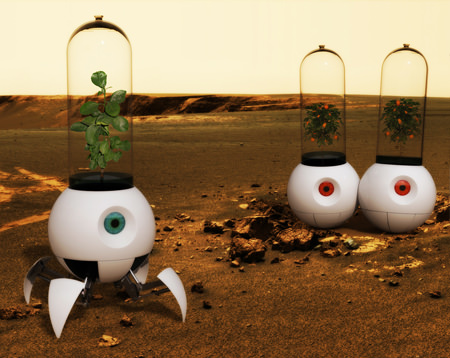
Now THIS is what I'm talking about! Every year Electrolux holds a competition for students to design concepts for future appliances, and they've just announced the eight finalists. My favs: a robotic greenhouse for Mars and a teleporting refrigerator. Le Petit Prince (Little Prince) is a robotic greenhouse concept that is specially designed to help the future exploration and expanding population when we colonize Mars. This intelligent robot carries and cares for a plant inside its glass container, which is functionally mounted on a four-legged self-transporting pod. Not only does it search for the optimum place to receive enough sunlight and other nutrients, it also send reports of its movements and developments to its fellow greenhouse robots through wireless communication. It was designed by Martin Miklica, from the Brno University of Technology in the Czech Republic. He said he was inspired by the book The Naked Sun by Isaac Asimov and R2-D2 from Star Wars (and surely Wall-E had something to do with this, too.)
See video of Le Petit Prince, below, and of the teleporting fridge.
(...)
Read the rest of Future Designs: Robotic Mars Greenhouse, Teleporting Fridge (122 words)
Loch Ness Monster On Google Earth?
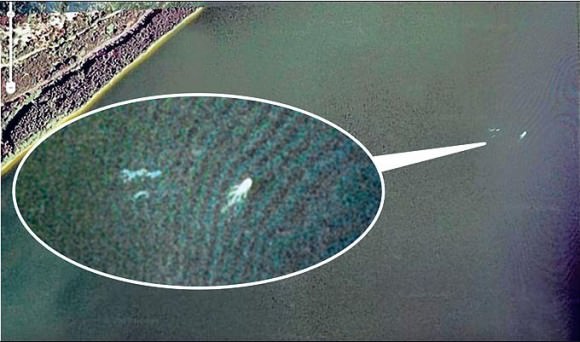
As only a British tabloid (and Fox News) could, reports came out this week of the Loch Ness Monster being spotted on Google Earth. "This amazing image on Google Earth could be the elusive proof that the Loch Ness Monster exists," The Sun reported. Well, for one thing, this doesn't look *anything* like Nessie. Doesn't he have a long black neck? And another thing about this: it looks surprisingly like a …. boat. Imagine that, a boat on a lake captured by Google Earth! Astounding! 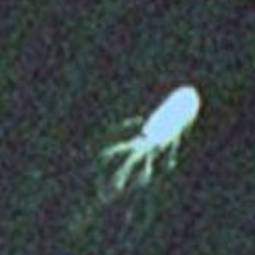 Look closely and you'll see the squared off back end of the boat (the stern), the rounded
Look closely and you'll see the squared off back end of the boat (the stern), the rounded stern bow in front, and the tentacle-looking things are just the boat's wake. This looks very much like another image of a boat on Loch Ness on Bing (below). Click on the picture to get to the image on Bing and zoom out for the full effect.
(...)
Read the rest of Loch Ness Monster On Google Earth? (53 words)
Mars Reconnissance Orbiter Goes Into Safe Mode Again

NASA's Mars Reconnaissance Orbiter put itself into a safe mode Wednesday morning, Aug. 26, for the fourth time this year. While in safe mode, the spacecraft can communicate normally with Earth, but aborts its scheduled activities, and awaits further instructions from ground controllers. "We hope to gain a better understanding of what is triggering these events and then have the spacecraft safely resume its study of Mars by next week," said MRO Project Manager Jim Erickson.
(...)
Read the rest of Mars Reconnissance Orbiter Goes Into Safe Mode Again (162 words)
LookUP to Find Astronomical Objects
Have you heard about LookUP? Stuart Lowe from the Jodrell Bank Centre for Astrophysics created this web tool to provide quick access to information about the the position and other details of specific astronomical objects. Instead of having to go search through an astronomical database, all you have to do is type in the name of the object (this doesn't apply for spacecraft) and LookUP contacts the relevant astronomical databases for you and provides info such as right ascension and declination. There's also mobile version, an application for iPhones, and a widget for your desktop. The newest tool will thrill all the astronomy Twitterers out there. Rob Simpson from Orbiting Frog fame created a Twitter account for LookUP. All you do is send a tweet to it with the name of your object, and it will send you the info and a link with for further information. For example, I wanted to know where Asteroid Apophis was, and LookUp Tweeted back: Apophis is at RA 10:35:13.594 dec 07:37:40.210 More info http://bit.ly/1aVqzG (that is valid for the time I sent the Tweet.) Check it out; it's all very quick and easy and wonderful for all you stargazers out there.
The Universe DVD Giveaway

In case you haven't heard, Season 4 of the History Channel's "The Universe" has begun. To help celebrate, they've generously offered to give away two sweet prizes related to the show. One person will get "The Universe Collector's Set", which contains Season 1, Season 2, and the 2 specials. And another person will get to choose between Season 1 on Bluray, or Season 2 on DVD.
To enter the giveaway, just email info@universetoday.com with the Subject Line: "Universe DVD Giveaway". I'll collect all the entries and pick two randomly as winners. Then I'll delete all the emails.
The deadline to enter is Monday, August 31st, 2009 at 12:00 noon (Pacific Time).
And if you want to check out The Universe now, you can buy full episodes on iTunes, order DVDs from the History Channel, and even watch it on the television. The next episode, "It Fell From Space" airs on September 1, 2009

